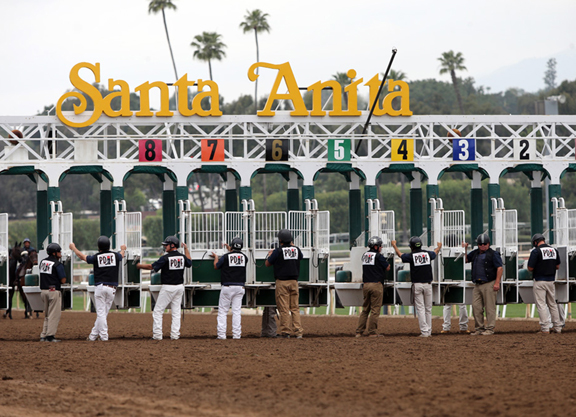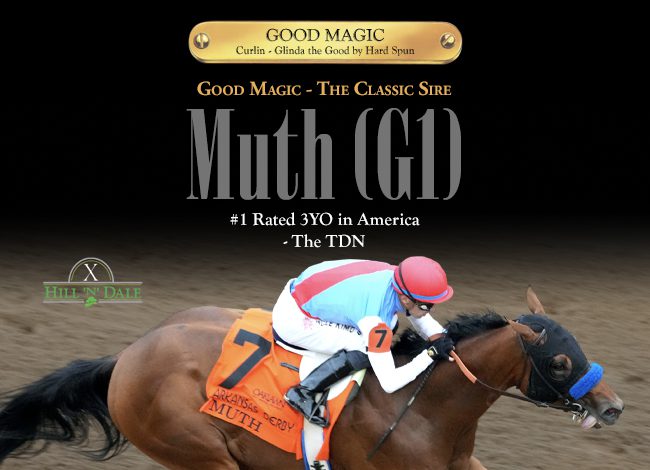By Dan Ross
What with the tremulous fault-lines quaking beneath their feet and the combustible topography of a wildfire-ripe urban sprawl, Californians carry like a heavy hex the everyday threat of nature's equalizing force.
Stakeholders in the state's racing industry have had to summon some of that same California fortitude this year thanks to an annus horribilis brought to a gut-wrenching nadir with Mongolian Groom's catastrophic injury in the GI Breeders' Cup Classic–a worst-case scenario for an industry hoping the worst was behind it that led to U.S. Senator Dianne Feinstein's renewed calls for racing to be suspended at Santa Anita. It's no wonder trainers there continue to be chastened.
“When people ask me what I do, I've always been really proud of the fact that I've got this incredible job where I get to work with the animals that I love,” said a down-beat Dan Blacker, early last week. “To go from that to almost, I won't say ashamed, but I just don't feel as proud anymore. I'm not as willing to promote the fact that I'm a horse trainer as I used to be.”
Though the dust is settling on this year's Breeders' Cup, the anxiety is hardly dissipating with it, two fatalities at Del Mar on Sunday furthering tensions. And so, just how do those caught in the crosswinds view the road forward?
What aren't required are reactionary “knee-jerk” changes, said The Stronach Group's (TSG) chief strategy officer, Aidan Butler, and that includes any decisions surrounding possible surface switches at Santa Anita.
In the weeks leading up to the two-day event, the steady drumbeat of change from dirt to synthetics grew in volume. During a pre-Breeders' Cup safety and security press briefing, for example, TSG chief veterinary officer Dionne Benson said that “nothing is off the table, including the potential to bring synthetic back.”
The reasons why appear clear. According to the Jockey Club's Equine Injury Database, the 2018 fatality rate on synthetic surfaces was 1.23 per 1,000 starts, as compared to 1.86 per 1,000 starts on the dirt.
Butler tells the same story as Benson. “We are looking at everything,” he said. “But what I don't want to do is throw in a synthetic track and work out the horses hate it, the horsemen hate it.”
If the “powers that be” decide to make the switch back from dirt to synthetics–Santa Anita's prior synthetic surface was ripped out in 2010–the decision would have to be pursued with an extensive period of research and evaluation, said Butler, who added that he has already been “in talks” with Michael Dickinson, who established the Tapeta racing surface.
According to figures from the British Horse Racing Authority and the Arena Racing Company, there have been 8,799 starts since the last catastrophic injury on the latest iteration of the Tapeta surfaces installed at Wolverhampton and Newcastle in England. Overall, there have been 0.03% fatalities over three years at both tracks.
“I've got to make sure that it works in the climate at Santa Anita out here,” Butler added. “It gets so cold in the mornings and so hot in the afternoons, you've got to make sure [the materials] won't turn to rack and ruin.”
Butler also confirmed that another idea had been floated: to make the main track a turf course, and the inner surface, currently grass, into a synthetic track.
“You can start to have the conversation: if you re-do any of the surfaces at the track, are you happy with the current format?” he said. “We know turf racing is on the rise. We know people love it. We know field size is generally better.”
Nothing, however, is set in stone, Butler said, stressing that no time frame for change has been nailed down.
“You've got to take a really careful, methodical approach to all of this,” he said.
Attitudes among the trainers towards a return to synthetics is mixed, admitted California Thoroughbred Trainers (CTT) president Eoin Harty, pointing to fears among some of a perceived connection between synthetic surfaces and a higher prevalence of training injuries (the TDN addressed this concern and the broad science behind synthetics surfaces in this lengthy story from earlier this year).
“I haven't polled the entire Santa Anita horse community to find out where they stand,” Harty said. “But I think we're past the point of being averse to the synthetic track going in. We've tried every form of dirt surface possible, we've got the best track man out there, and we still can't stop having these fatalities.”
A self-professed “fan” of synthetic surfaces, Harty said that he would like to see it installed “as soon as possible,” though he added that he has no personal knowledge of a possible timeline moving forward.
In the meantime, Harty said he believes the dirt surface at Santa Anita, currently riding deep and slow, could be modified to make it less taxing on the horses.
“I know the track superintendent [Dennis] Moore has done everything he can to prevent the loss of life,” he added. “The breakdowns have been minimized, but they're still happening.”
More broadly, Harty said that he hopes any further changes in California will be made transparently, to promote a greater sense of “stability” across the backstretch.
“People will know which direction we're going in, and we'll plan accordingly,” Harty added. “Just the trepidation around here right now, without knowing exactly what direction we're going in is making a lot of people nervous.”
One of those people is owner-breeder Tim Cohen of Rancho Temescal.
“The hard part is the uncertainty,” said Cohen. “It's hard to invest when you have no idea where we're headed. That comes from everybody, from the regulators, from management.”
Not that he believes the state reforms instituted since the spring have been misdirected.
“Anything that assures or has a better opportunity for helping the horses on the racetrack, anything that improves rider and horse safety is good,” Cohen said.
Rather, Cohen repeated a criticism he has made before–a need for greater stakeholder inclusion in decision–making processes.
“A broader consensus, that's what we need,” he said. “We need broader consensus and we need broader involvement to solve this problem.”
Looking at the problem numerically and in isolation can offer conflicting stories. Del Mar, for example, boasted an “unprecedented” safety record of zero race-day fatalities from 2,372 starts during its summer meet. Before that, Santa Anita went six weeks without a catastrophic injury during training and racing. But during the recently concluded Santa Anita fall meet, which ran from Sept. 27, and Nov. 3, there were seven fatalities in all, four during racing and three training, one of which was before the meet began (this number includes a sudden cardiac death).
However, fatality numbers in Southern California since Mar. 14, when broad safety protocols were enacted and the inclement winter weather had largely ended, show the state in a positive light when held up to national numbers. Since that date, the fatality rate across Santa Anita, Del Mar, and afternoon Thoroughbred racing at Los Alamitos has been 1.51 fatalities per 1000 starts, both on dirt and turf (this includes a freak accident at Los Alamitos).
“We can't look at a six-week period and say it has or hasn't worked,” said Benson, who argues the safety protocols instituted this spring are working. “Just to give you an idea, within the last week, I heard from two separate veterinarians about three horses that were retired based on what we have been doing.”
Looking ahead, Benson views the future arrival of more sensitive imaging modalities to Santa Anita–a Positron Emission Tomography (PET) scan unit and a standing magnetic resonance imaging (MRI) unit-will help significantly to eliminate the “grey area” in diagnosing problems earlier.
Pre-existing injuries, which aren't always clinically apparent, are present in more than 85% of catastrophic breakdowns, studies have shown. But those using these modalities, however, will have to acclimatize to the equipment, Benson warned.
“It's just like when we switched from traditional radiology to digital radiology, and how we could see so much more, you have to know what the more that you're seeing means clinically for a horse,” she said.
Many of those approached for this story discussed their frustration of wider industry trends that can factor into catastrophic injuries–breeding and conformation patterns, for example, and the preparation of young stock for the sales–are too often left out of the conversation.
“Everybody's got to be willing to give up what they're holding on tight to for the betterment of the horse and horse racing,” said Southern California-based private veterinarian, Ryan Carpenter. “And that's everybody, from management and how they're writing races, to owners who have expectations for what their horses should and shouldn't be doing.”
According to the California Horse Racing Board's (CHRB) equine medical director Rick Arthur broader structural changes to the calendar are needed to avoid the over-racing and over-training of an already depleted horse inventory in the state.
“In my opinion, we do not have enough horses in Southern California to race quality racing four days a week,” Arthur said, pointing to a period in California's history–before Hollywood Park's fall meet was established in the early 1980s–when the calendar was less intense. “I would make sure there are breaks between meets, a minimum of two weeks.”
Another area of uncertainty concerns possible changes to use of the riding crop, which, as proposed earlier this year, would make it an offense to use it for anything but safety purposes–a contentious issue once again brought to prominence in light of Mongolian Groom's catastrophic injury in the Breeders' Cup.
“Mongolian Groom was whipped as he came around the final turn, so even if he was in pain and wanted to slow down, he could not have done so,” PETA stated in a subsequent press release.
Discussion and action of the proposed rule change is on the agenda at the next CHRB meeting Nov. 21, though the specific language of the proposed rule for discussion and action is not yet publicly available.
According to Jockey's Guild manager, Darrell Haire, his organization believes the current rules already protect horses against rider abuse and need no further modification.
“We have the most stringent rules in the nation,” said Haire, adding that his organization has been in discussions in recent weeks with industry stakeholders, including members of the CHRB. “If a rider abuses a horse, they should face severe punishment. But that's already happening.”
And yet, as under siege as the industry appears at present, there's “light at the end of the tunnel,” said Harty. “For the first time in memory, it looks like every horseman's group and racetrack is pulling together with the same oar,” he said. “I think we all realize the precariousness of the situation.”
Not a subscriber? Click here to sign up for the daily PDF or alerts.






